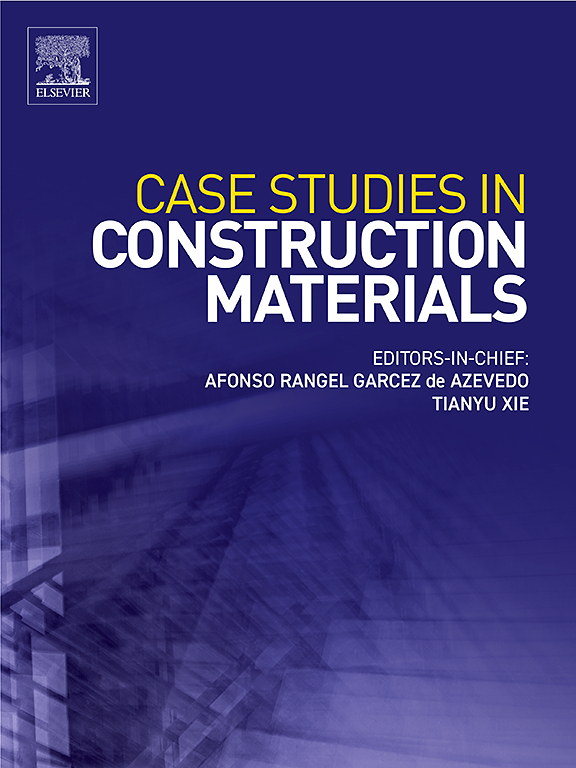Improving the post-fire performance of reinforced concrete beams with lightweight plaster
IF 6.6
2区 工程技术
Q1 CONSTRUCTION & BUILDING TECHNOLOGY
引用次数: 0
Abstract
Structural fires pose significant risks to the built environment, making fire resistance a critical design consideration for reinforced concrete (RC) structures. Elevated temperatures during fires reduce the strength and stiffness of both concrete and steel reinforcement, compromising load-bearing capacity. This experimental study evaluates the effectiveness of lightweight plaster coatings in enhancing the post-fire performance of RC members exposed to ISO 834 standard fire conditions. Two materials, expanded vermiculite (EV) and expanded perlite (EP), were examined. First, the compressive strength of concrete mixes incorporating EV or EP as partial replacements (2.5 %, 5 %, 7.5 %, and 10 %) for fine aggregates was assessed after heating durations of 30–120 min. Subsequently, structural performance was tested in RC beams across three configurations: (1) EV or EP integrated into the mix, (2) EV or EP applied as external plaster, and (3) a combination of both. A total of 54 RC beam specimens were cast, with 12 beams used for internal temperature monitoring and 42 subjected to four-point bending tests following 60, 90, and 120 min of heating. Concrete grades M20 and M50 were developed using EV or EP as partial sand replacements, while plaster layers were prepared with EV or EP mortar. Key performance indicators, including load-deflection response, ultimate load, internal temperature distribution, residual rebar yield strength, and first-crack load, were analysed. The protected M20-EP+EPC beam recorded a 62.2 % reduction in rebar temperature compared to the unprotected M20-R beam. Further, the loss of yield strength was reduced by 87.5 %, and the moment of resistance degradation was reduced by 61.1 % compared to the unprotected M20-R beam. Beams protected with EV or EP in both the mix and external plaster demonstrated superior performance, extending survival time from 45 to 120 min and improving fire resistance ratings from 15 to 60 min based on insulation criteria.
用轻质灰泥改善钢筋混凝土梁的火灾后性能
结构火灾对建筑环境构成重大风险,使耐火性能成为钢筋混凝土(RC)结构设计的关键考虑因素。火灾期间的高温降低了混凝土和钢筋的强度和刚度,影响了承重能力。本实验研究评估了轻质石膏涂层在提高暴露于ISO 834标准火灾条件下RC成员的火灾后性能方面的有效性。研究了膨胀蛭石(EV)和膨胀珍珠岩(EP)两种材料。首先,在加热30-120 min后,对含有EV或EP作为部分替代品(2.5 %,5 %,7.5 %和10 %)的混凝土混合物的抗压强度进行了评估。随后,在三种配置的RC梁中测试了结构性能:(1)EV或EP集成到混合料中,(2)EV或EP作为外部石膏,(3)两者的组合。总共铸造了54根RC梁试件,其中12根梁用于内部温度监测,42根梁在加热60、90和120 min后进行四点弯曲试验。混凝土牌号M20和M50采用EV或EP作为部分砂替代品,而灰泥层采用EV或EP砂浆配制。分析了关键性能指标,包括荷载-挠度响应、极限荷载、内部温度分布、钢筋残余屈服强度和初裂荷载。与未受保护的M20-EP+EPC梁相比,受保护的M20-R梁的钢筋温度降低了62.2 %。此外,与无保护的M20-R梁相比,屈服强度损失降低了87.5 %,阻力退化力矩降低了61.1 %。在混合料和外部石膏中使用EV或EP保护的梁表现出优异的性能,将生存时间从45延长到120 min,并根据绝缘标准将耐火等级从15提高到60 min。
本文章由计算机程序翻译,如有差异,请以英文原文为准。
求助全文
约1分钟内获得全文
求助全文
来源期刊

Case Studies in Construction Materials
Multiple-
CiteScore
7.60
自引率
19.40%
发文量
842
审稿时长
63 days
期刊介绍:
Case Studies in Construction Materials provides a forum for the rapid publication of short, structured Case Studies on construction materials. In addition, the journal also publishes related Short Communications, Full length research article and Comprehensive review papers (by invitation).
The journal will provide an essential compendium of case studies for practicing engineers, designers, researchers and other practitioners who are interested in all aspects construction materials. The journal will publish new and novel case studies, but will also provide a forum for the publication of high quality descriptions of classic construction material problems and solutions.
 求助内容:
求助内容: 应助结果提醒方式:
应助结果提醒方式:


